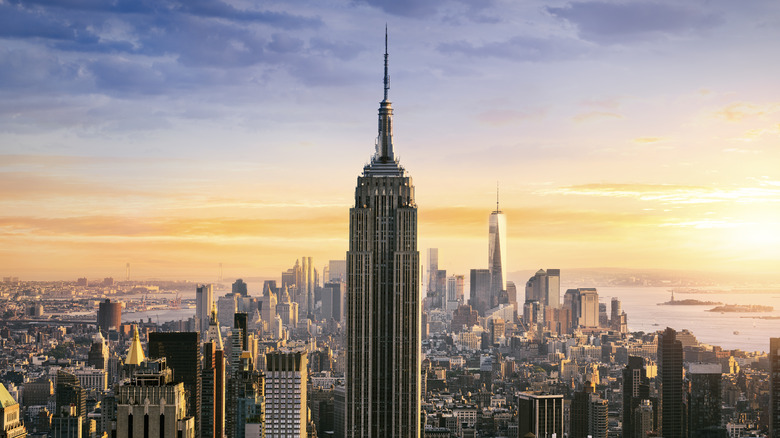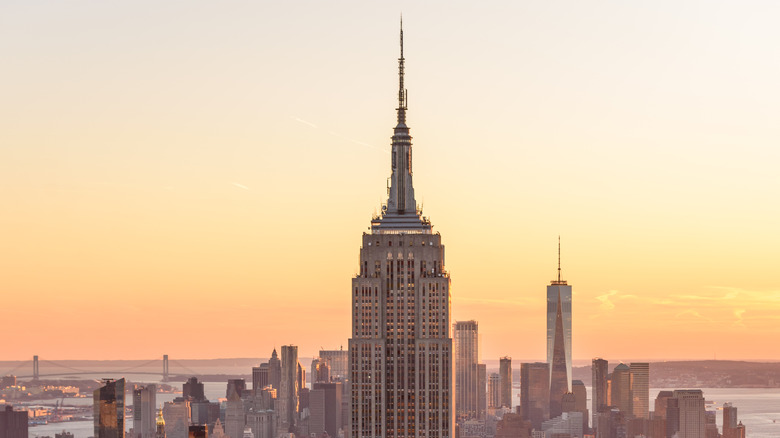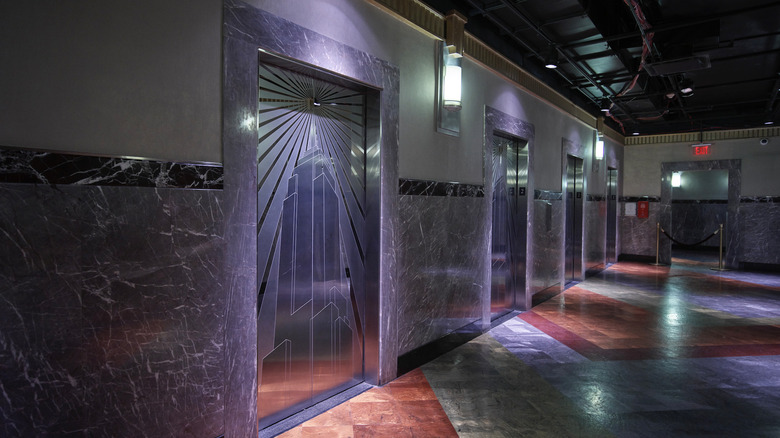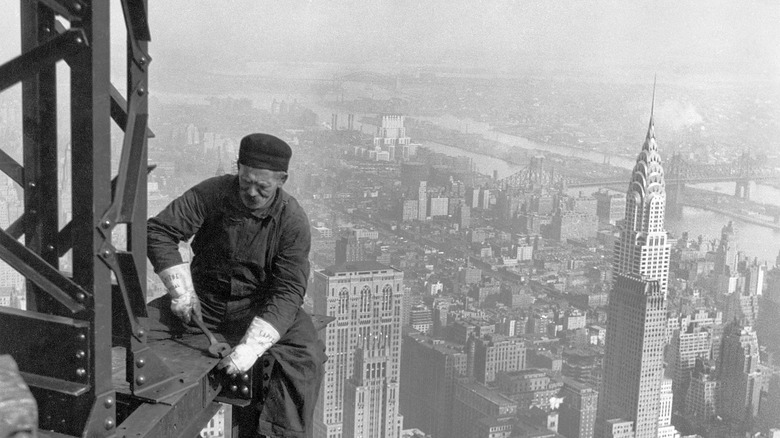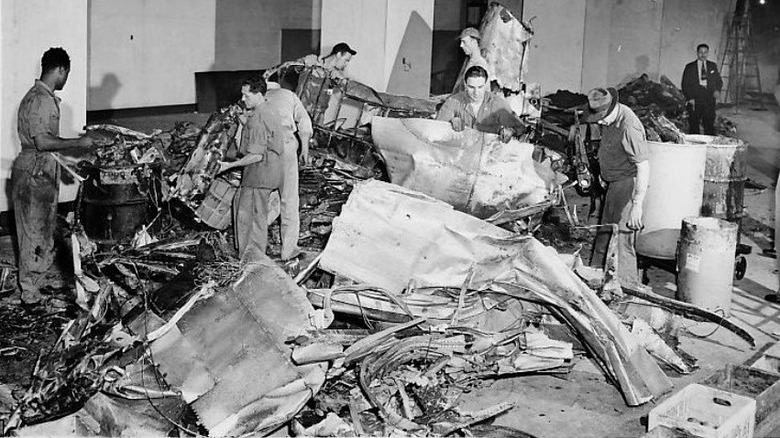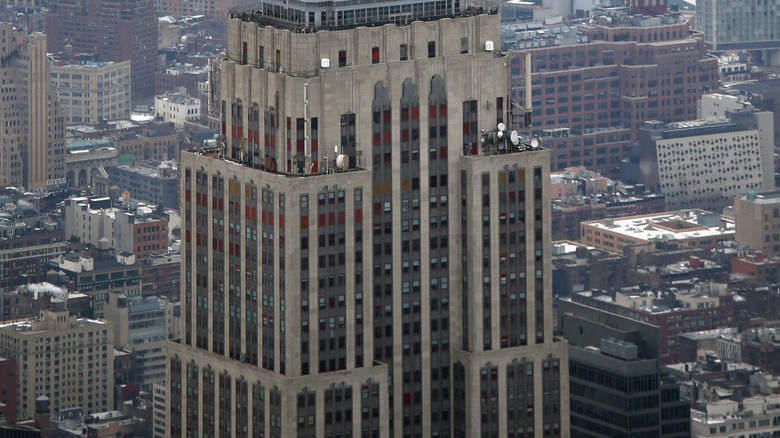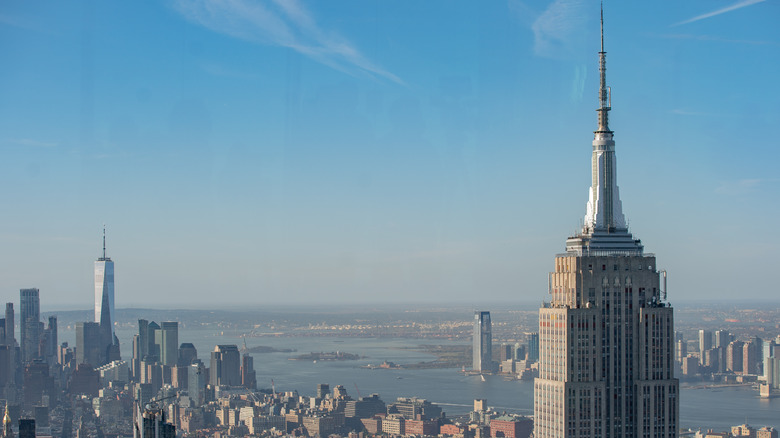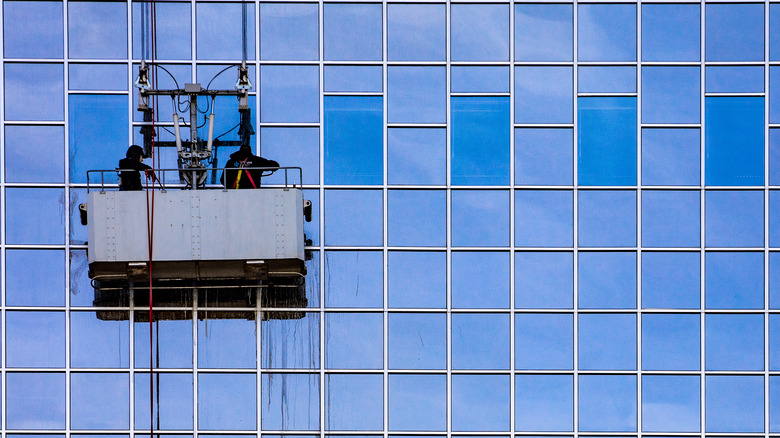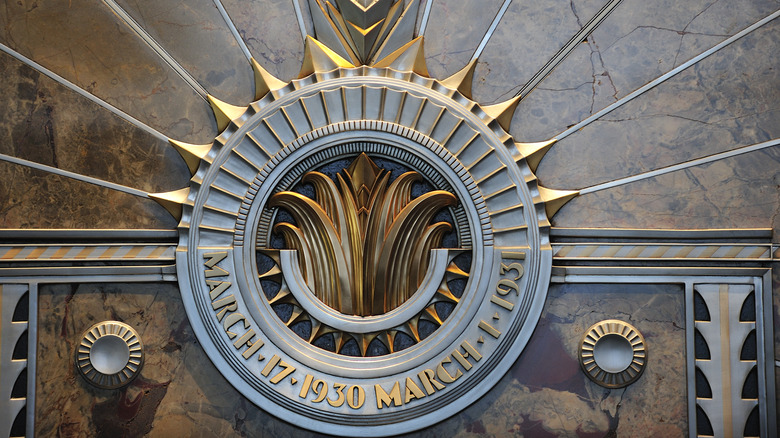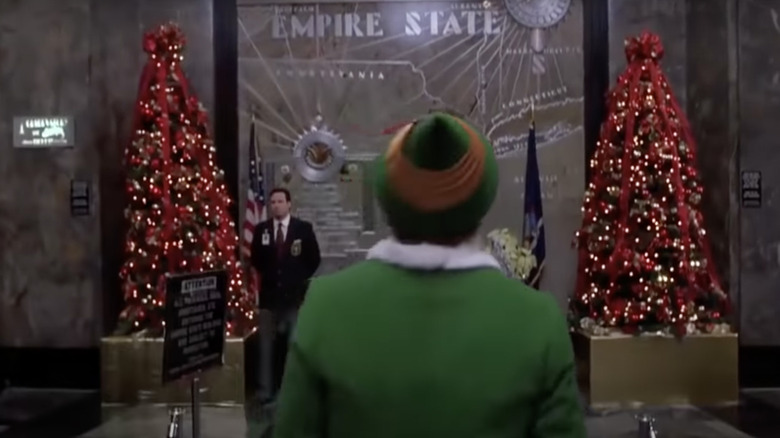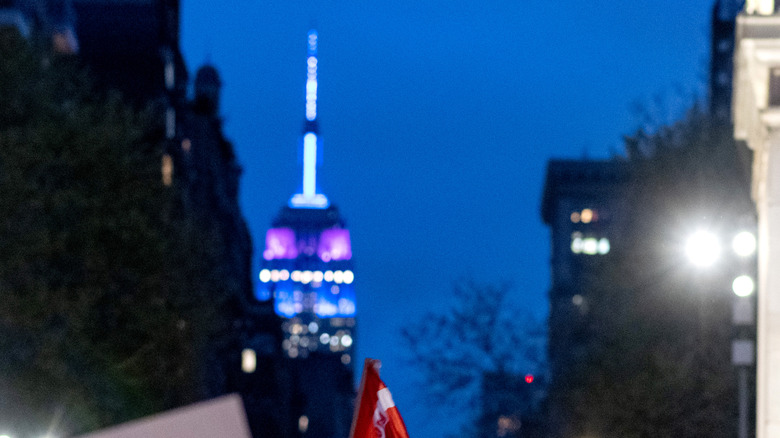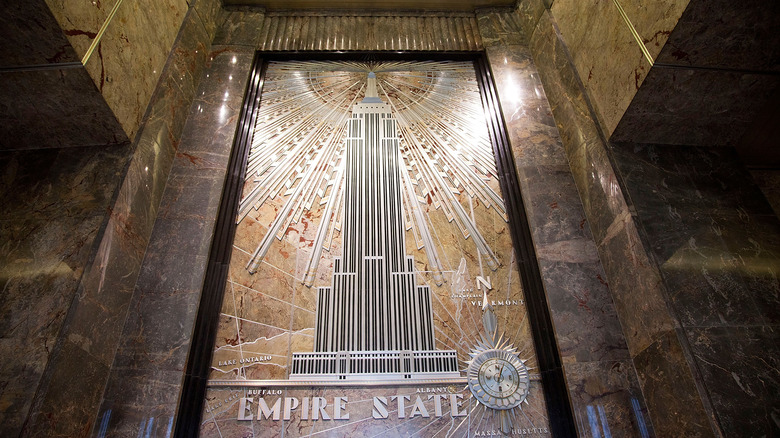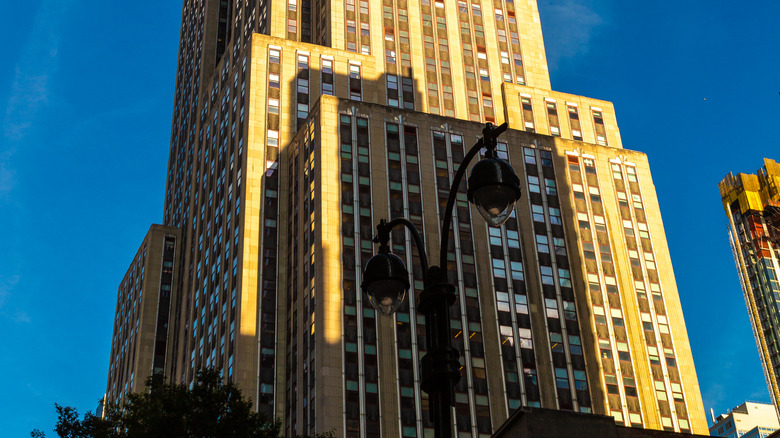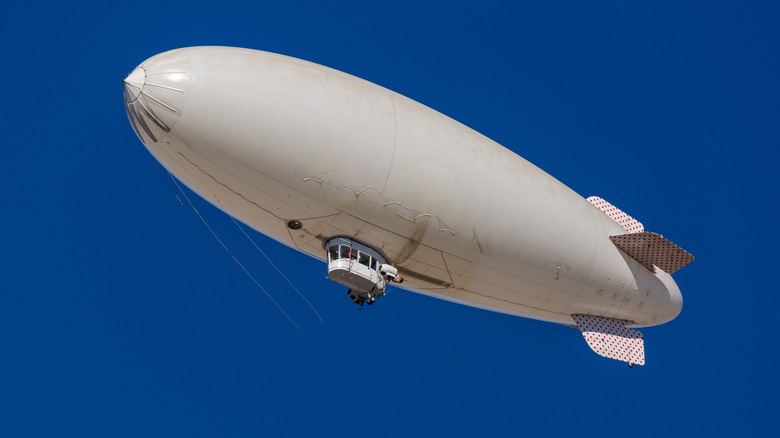The Untold Truth Of The Empire State Building In NYC
The Empire State Building is an American icon. It's one of the most recognizable features of the New York City skyline and was, for a period in time, the tallest building in the world. According to the BBC, the global affection for the structure is almost as high as its 102 floors.
The structure is one of the first things that tourists to Manhattan want to see. Through its record-breaking conduction during the Great Depression to its iconic status in the modern era, the art deco tower has been the backdrop to plenty of history. It has been the site of marriage proposals, deaths, plane crashes, and even being attacked by King Kong himself. However, even if you have had the chance to visit the tower in person — or consider yourself well-versed in New York history — there are still many untold truths to discover about the city's crowning jewel.
A race for the world's tallest skyscraper sparked the Empire State Building's construction
According to Leading Edge, from 1929 to 1931, there was a race between real estate developers in New York City to construct the world's tallest building, which at the time was the Woolworth Building. The idea for the building originally belonged to John Jakob Raskob, an early American venture capitalist. History doesn't remember him too fondly because he is now infamous for encouraging massive investments into the stock market just before the 1929 crash. However, at the time, he was thought of as a visionary, sort of like a 1920s Elon Musk (via Time).
Raskob's idea to build a record-breakingly tall building employed nearly 3,500 throughout the Depression, creating much-needed work for people. When pitched, Raskkob said the tower would be a "monument to the future." And, in the midst of the Great Depression, it would serve as hope for a nation of people that "reached for the sky with its feet on the ground."
Its short construction time set records
The Empire State Building set records for its speedy construction. According to Big 7 Travel, the entire building only took 410 days to complete, from breaking ground to the final screw being tightened. Since the whole building is 102 stories tall, some quick math reveals that the tower rose by almost two stories a week. Once completed, it was the tallest building in the world until the World Trade Center twin towers were completed in 1970. As the first staple of the New York City skyline, it must have been a sight to behold.
While some craftsmen earned up to $15 a day for their work, many were paid much less than that, even though they worked under very dangerous conditions. However, even though the work was quick and performed without modern safety mechanisms, the quality of the craftsmanship has stood the test of time as the tower still hosts hundreds of tenants and thousands of tourists each year.
Five workers lost their lives during construction
Unfortunately, the lack of modern workplace safety requirements had a heavy cost during the tower's construction. According to Bindley Hardware Co., records state that five men lost their lives as the building went up. Unofficially, it's said that many more died, but if true, those deaths were not officially recorded. There were two leading causes of death: Slipping and falling from the grand heights of the building, or being hit with heavy falling materials. This could be anything from a falling metal beam, or even a simple tool if it were dropped from high enough up the tower. Hard hats were not required until 1970, leaving workers at high risk at this job site (via The New York Times).
Even with these incidents, the construction of the Empire State Building was not without any sort of safety measures. Some floors had safety nets stretching out underneath them in case any workers slipped and fell, as well as other kinds of webbing between layers of steel.
A U.S. Army Air Force B-25 bomber accidentally crashed into the building in 1945
According to NPR, the morning of July 28, 1945, was a very foggy one in New York City. The war in Europe was all but over, and Japan's surrender would come later that summer. Captain William F. Smith was back home from the war and tasked with moving fellow military personnel in a B-25 bomber from Massachusetts down to LaGuardia Airport. Due to heavy fog, Smith radioed ground control to ask for advice and was advised to abort the landing. However, he ignored this advice. He began a turn for what experts assume to be lining up to land, but due to heavy fog, he was unaware he was right over midtown Manhattan. As his altitude declined, the clouds must have cleared, and he plowed into the building.
"In the other side of the office, all I could see was flames," said Fortier Willig, who was working on the 79th floor that day. "Mr. Fountain was walking through the office when the plane hit the building and he was on fire — I mean, his clothes were on fire, his head was on fire. Six of us managed to get into this one office that seemed to be untouched by the fire and close the door before it engulfed us. There was no doubt that the other people must have been killed." In total, there were 14 fatalities, three on the plane and 11 in the building.
The plane destroyed an elevator shaft, causing the lift to plummet 1,000 feet
The crash of the same B-25 airplane severed an elevator shaft which sent elevator attendant Betty Lou Oliver into a free fall. She had been working on the 80th floor when the plane crashed into the 79th. Miraculously, she survived. According to Guinness World Records, Oliver still holds the world record for the longest survived fall in an elevator. The force of the crash severed each of the elevator's cables, even the safety cable, so there was nothing to slow the cart's fall through the shaft except the air pressure in the tight space. This was luckily just enough to make the fall survivable for her.
However, Oliver did walk away with life-changing injuries. The sudden impact of the elevator onto the bottom of the shaft broke her legs and spine. She was also heavily bruised and cut from the flying debris. However, Oliver was determined to recover. After only four months in the hospital, she had healed enough to regain her ability to walk (via The Natchitoches Times).
It was called The Empty State Building for years after it first opened
After the race to build the Empire State Building in record time, the building's developers found renting out office space challenging. According to Time, the building has over 2 million square feet of available office space. And, in the 1930s, there were not a lot of businesses that were in the place financially to rent it out. In fact, the building was only at 25% occupancy for most of the 1930s and even into the 1940s, as war blossomed in Europe and the Pacific.
"So much new space came onto the market at exactly the same time," said Carol Willis, director of the Skyscraper Museum. "All of those buildings were competing with each other for new tenants at a time when businesses and sales were shrinking. More new space, smaller business demands — all the new buildings suffered." The building's observation deck, offering sparkling views of the city and beyond, paid its bills until well into the 1950s, when tenants finally started moving in.
Daredevils have parachuted from the building's observation deck
In April of 1986 two men jumped off the 86th floor of the Empire State Building, luckily with parachutes. They seemed to be participating in the extreme sport of base jumping. British man Alastair Boyd, age 27, landed safely on Fifth Avenue, quickly hailed a cab, and fled the scene. His companion was 25 year old Michael McCarthy also from London. Michael also landed uninjured, but got his ropes tangled up in a nearby traffic light.
While he worked to get himself down, the police arrived and arrested him as soon as his feet touched the ground. The building had not sanctioned the jump, so it earned him jail time. ″It was quite frightening,″ said Michael. ″I mean, it's not a normal thing to do.″ Because Boyd was not caught at the scene, he wasn't arrested or charged, but McCarthy, who had also jumped from the Eiffel Tower in Paris, dealt with a reckless endangerment charge.
Window washers have cleaned all sorts of things off its outsides
Being a window washer is a dangerous, but exciting job. This is especially true if you are one of the elite washers responsible for cleaning the windows of New York City's towering skyscrapers. According to The New Yorker, when the Empire State Building was completed in 1931, a team of eight men worked across two shifts to clean each of the 6,500 windows on the tower.
The job is definitely not for the faint of heart, as sometimes the men had to balance on ledges that were no more than two inches wide to get the job done. It also might not be a job for someone who doesn't have a strong stomach, too, as employees in the Empire State Building often tossed their lunches out the window when they could still open. "They throw sh*t out of the windows all the time," said Bob Menzer, who started cleaning the tower in 1989. "One time, they threw, like, twenty gallons of strawberry preserves—and it went through ten floors, all over the windows. And it was the winter, so it froze on there, and we couldn't get it off."
The Empire State Building is a glowing example of art deco
The Empire State Building was built during the height of the art deco movement. According to Arch20, it's one of the best examples of the style that we have today. Generally, art deco is characterized by a few key features: extreme ornamentation, metallic colors, and geometric shapes. The original design for the building was put together by Shreve, Lamb & Harmon, a New York-based architectural firm, and has all of these things.
Art deco design also likes to draw on features from other civilizations, which we see in the Empire State Building because its top floors appear to form the same zigzag shape found in Mesopotamian structures. But the showcase doesn't stop there, as the inside of the tower features marble floors, glowing golden accents, and fun geometric shapes nearly bursting from its walls. However, these golden accents are not just golden in color. They are actual gold: 24-karats to be exact.
The building is a favorite meeting place in movies and TV
According to Entertainment Weekly, there are almost too many movie moments that take place at the Empire State Building to count, but a few fan favorites tend to be "King Kong," "Sleepless in Seattle," and even "Elf." "Sleepless in Seattle" was released in 1993, but fans still swoon over Sam and Annie's chance encounter at the top of the tower on the observation deck. However, anyone who has actually been out on the observation deck might wonder why it doesn't seem to be that windy in the movie.
In "Elf," Buddy the elf's father works inside the Empire State Building at a publishing company, so viewers are treated to delicious views of the building's elaborate art deco lobbies, hallways, and even elevator system. And of course, who could forget King Kong climbing the Empire State Building with actor Fay Wray dangling from one hand as he swatted away airplanes with his other. As the film was released in 1933, it was filmed in a studio rather than on site, but the Empire State Building sequence represented cutting-edge animation technology at the time.
The building lights up for various events and causes
The Empire State Building is an iconic part of the New York City skyline. Even so, the building's management keeps visitors and locals alike on their toes by changing the colors of the tower's exterior lights to honor various events and causes. This could be something like red, white, and blue in celebration of the American Bicentennial in 1975, and rainbow colors for Pride each June.
According to Live Science, the very first event marked by a light show at the Empire State Building was a single white beam shown from the building to celebrate Franklin D. Roosevelt's victory in the presidential election in November 1932. From there, four moving lights were added in 1956 and were dubbed the Freedom Lights. The building receives many requests for light shows, so in August 2006, building management formed a Lighting Partner program so that each application could be given proper attention and placed on the schedule. This ensures that each request is legitimate and that the city skyline gets a break from multicolor displays in favor of simple white every once in a while.
Each year, the building hosts a run up
Each year, hundreds of the world's best (and craziest) athletes gather to raise money for a great cause by running up the Empire State Building. According to InsideHook, the event is organized by the group NYCRUNS and sponsored by Turkish Airlines. Although the tower has 102 floors, participants only make their way up 86 flights, which is still one of the most physically demanding activities a person can do. That's because they aren't just walking up — they are running as fast as they can.
However, just like during a regular marathon — or any other athletic event — slow and steady wins the race. If you use all your energy at the starting line, you'll quickly fall behind, at least according to former participant Don Saladino. He was one of the first ones to the top and expressed his awe on running all the way to the top and bursting out onto the tower's iconic observation deck to take in the view of New York City. The year he participated, he raised over $200,000 for a charity in Norway.
The Empire State Building has its own ZIP code
Typically, entire towns can have just one ZIP code, but the Empire State Building has so many residents working there that the building actually has one of its very own: 10118. According to AM New York Metro, it's one of a few buildings in NYC to have the honor. "Unique ZIP codes are sometimes assigned based on the volume of mail at a particular address — and only when a ZIP+4 will not satisfy delivery, distribution, and customer requirements," U.S.Postal Service spokesman Xavier Hernandez told the outlet.
So, because of the massive amounts of mail delivered daily to the more than 150 individual businesses inside the Empire State Building, the post office decided that to efficiently schedule mail carriers and sort incoming parcels, the building needed its own ZIP. Because if it didn't, there would be some confusion in local post offices around the volume of mail headed to one part of town, and the smaller businesses located around the tower might suffer from slower service and other delays (via the Empire State Building).
There used to be an airship dock on the tower's very top
Before the Hindenburg disaster, many thought airship travel was the future, so the Empire State Building was originally designed to have an airship dock on the very top of the tower. According to Smithsonian Magazine, a 1928 ticket from Europe to the United States on an airship was about $3,000, roughly $40,000 today when adjusted for inflation.
Alfred E. Smith was the lead investor in the building's construction and intended for passengers to disembark their ship by way of a gangplank at the top of the tower. Next, they could take an elevator down to the ground floor and be out in the heart of the city, exploring Manhattan. The Graf Zeppelin commercial ship was due to dock there, but plans never actually moved forward due to logistical challenges. One smaller ship did briefly dock at the tower in 1931, but plans were abandoned shortly after.
